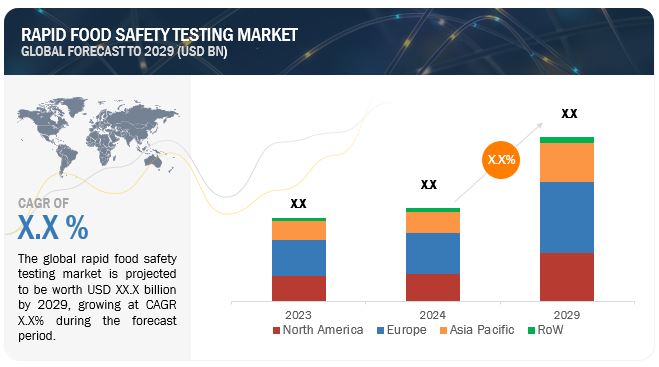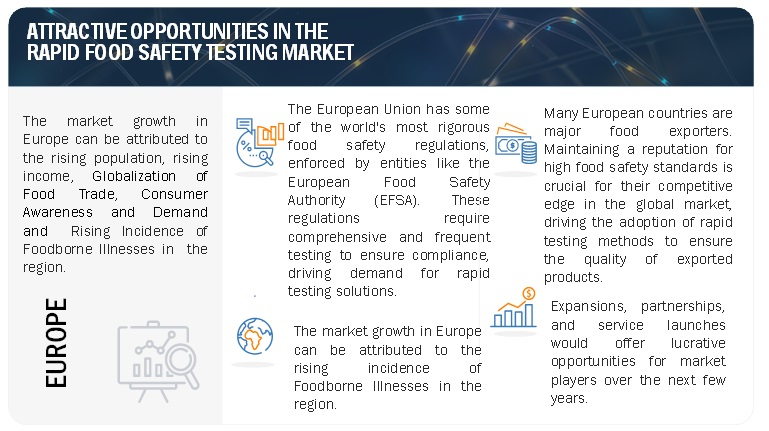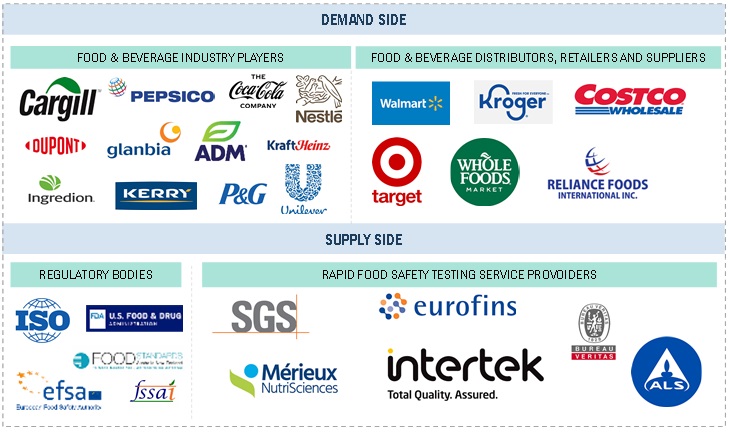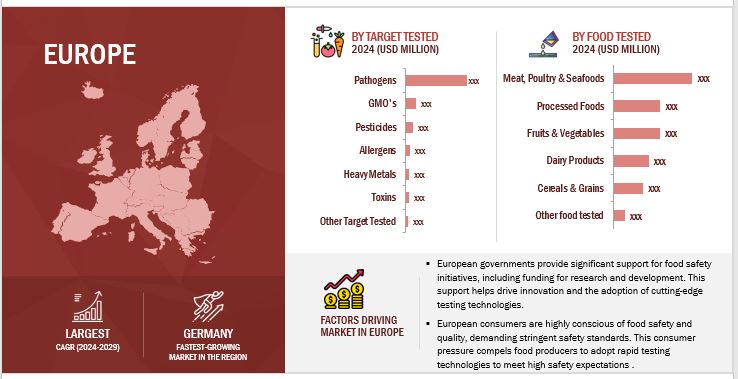Rapid Food Safety Testing Market by Target Tested (Pathogens, GMO’s, Pesticides, Toxins, Allergens, Heavy Metals, and Other Targets Tested), by Technology (Convenience-Based Testing, PCR-Based Testing, Immunoassay-Based Testing And Chromatography & Spectrometry) Food Tested (Meat, Poultry & Seafood, Dairy Products, Processed Foods, Fruits & Vegetables, Cereals & Grains and Other Food Tested), and Region - Global Forecast to 2029
The Rapid Food Safety Testing Market is estimated at USD XX.X billion in 2024 and is projected to reach USD XX.X billion by 2029, at a CAGR of 9.2% from 2024 to 2029
Rapid food safety testing is a scientific method that determines whether food is safe based on its microbiological, physical, or chemical composition. Rapid food safety testing needs to be accurate, definite, reproducible, established, and economical. Proper food safety testing helps to address the world's growing demand for safe food and the sustainability of the supply.
Every year, food safety issues cause economic losses in countries all over the world. It has been estimated that low- to middle-income countries suffer at least USD 100 billion in losses per year due to foodborne illnesses. Access to a clean, safe, and sustainable food supply is essential for human survival. Therefore, the food business has established a set of testing procedures for food safety. Proper food safety testing and quality assurance help minimize challenges related to foodborne illnesses, food loss, and production of unsafe food. Food safety testing can also be used to evaluate foods that have been altered to withstand drastic conditions. The results from such tests can inform and educate the public about the safety or risks of such foods.
The implementation of strict regulations by various leading food safety organizations, including the Food Standards Agency, European Food Safety Authority, Food Safety and Standards Authority of India, and Canadian Food Inspection Agency, is expected to fuel the growth of the global food safety testing market.

To know about the assumptions considered for the study, Request for Free Sample Report

To know about the assumptions considered for the study, download the pdf brochure
Drivers: Advancing rapid technology
Accurate and fast microbiological testing is crucial for the food industry to prevent and control the spread of foodborne diseases. As a result, innovative scientific techniques for microbiological analysis have been developed, enabling real-time results for the presence of harmful microbial contaminants in food. Unlike traditional culture-based methods, which can take several days, rapid testing methods such as PCR, immunoassay-based techniques, and chromatography & spectrometry allow for timely analysis of larger sample sizes, reducing the time for food safety testing.
Furthermore, advanced technologies like immunoassay and chromatography & spectrometry ensure the detection of biological and chemical food contaminants, resulting in increased adoption and driving the market for rapid food safety testing.
The range of accessible chemical and microbiological methods for food safety testing continues to expand, with scientists and researchers discovering more efficient and faster technologies. Novel testing devices with speed, sensitivity, and selectivity are advancing chemical contaminants analysis. Additionally, sample preparation techniques like QuEChERS (Quick, Easy, Cheap, Effective, Rugged, and Safe) do not require pre-concentration processes and only need minimum extract clean-up, making them easier to automate. The use of QuEChERS-based preparations has increased rapidly to include testing for additional contaminants such as antibiotics and substances in a wide range of food matrices such as meat, fish, and wine.
Advancements in gas chromatography high-resolution mass spectrometry equipment and associated software tools have shown great potential, allowing for non-targeted testing and detection of known and unidentified chemical contaminants and environmental pollutants in the food supply chain.
Restraints: Difficulties in detection of unknown adulterants by chemical tests
The use of chemical tests for adulteration testing is widespread in both in-house and third-party laboratories due to their cost-effectiveness. However, many chemical tests have limitations in detecting and quantifying unknown adulterants. Additionally, other screening methods used in laboratories also have shortcomings in detecting and quantifying unknown adulterants. These methods typically target known adulterants during testing. For example, in the adulteration of dairy products, melamine is a common target for screening. However, it is possible for melamine to be substituted with an untargeted adulterant such as urea, leading to inaccurate results and food fraud.
Opportunities: Spike in food safety concerns after COVID-19
According to the World Health Organization (WHO) report released in 2020, unsafe food contributes to 420,000 deaths and 600 million cases of foodborne illnesses every year worldwide. Children under the age of five account for 30% of these deaths. WHO estimates that 33 million healthy years of lives are lost due to consuming unsafe food globally each year, and this number is likely to be an underestimation. The WHO states that the global burden of Foodborne Diseases (FBDs) is comparable to that of malaria, HIV/AIDS, or tuberculosis. Low- and middle-income countries bear 98% of the global FBD burden, with Africa having the highest per capita burden and Asia having the highest total burden. COVID-19 has significantly influenced consumer perceptions of food safety. Although the novel coronavirus is mainly transmitted through airborne respiratory droplets and the risk of contracting it through contaminated food is considered low, people worldwide are noticeably more concerned about disease risk from food. This increased awareness and demand for better food hygiene may put pressure on value chain participants to ensure food safety. Both the USDA and FDA have taken action in response to the COVID-19 crisis. The most significant challenges related to the pandemic's impacts on food safety are supply chain management, recalls, and inspections.
Challenges: High cost associated with procurement of food safety testing equipment
Toxicity and contaminant detection in agricultural and food products traditionally rely on analytical techniques like thin-layer chromatography, high-performance liquid chromatography, gas chromatography, and gas chromatography combined with mass spectrometry. While these methods are reliable, they come with high initial costs and equipment space requirements. The increasing focus on R&D activities and the demand for accuracy and reliability of readings contribute to the rising prices of these instruments. Moreover, since most of these testing instruments are exported in large quantities from developed countries in North America and Europe, it adds to the cost of procuring the technologies, especially for developing economies.
Automated testing instruments are equipped with advanced features and functionalities but come at a premium price. For example, spectroscopy-based systems can range from USD 150,000 to USD 850,000. The overall cost, including the instrument, media, and labor, can be high for some end users. Additionally, installing and using in-line spectroscopic technologies for quality assurance and control involves a considerable initial cost and the need to develop a robust statistical model for a particular supplier's product. As testing laboratories require many such systems, the overall capital cost investment increases significantly. Academic research laboratories often cannot afford such systems due to limited budgets. Furthermore, maintenance costs and other indirect expenses contribute to the overall increase in the total cost of ownership of these instruments. These factors are significant barriers to the widespread adoption of automated testing technologies in the rapid food safety testing industry.
Market Ecosystem

Based on the target tested, pathogens is estimated to account for the largest market share of the rapid food safety testing market.
In developed countries, millions of cases of infectious gastrointestinal diseases are reported each year due to foodborne pathogens, costing billions of dollars in medical care and lost productivity. New emerging foodborne pathogens and diseases are likely driven by factors such as pathogen evolution, changes in agricultural and food manufacturing practices, and changes in the human host status. In the US and Canada, food safety inspection for pathogens has been conducted progressively. For instance, in October 2021, USDA announced that FSIS (Food Safety and Inspection Service) would be strengthening efforts to reduce Salmonella illnesses associated with poultry products.
The increasing cases of foodborne diseases and the growing importance of food safety have significantly raised the demand for rapid food safety testing services in recent years. Population-based surveillance for laboratory-diagnosed infections revealed that most infections and outbreaks were caused by Campylobacter, Cryptosporidium, Cyclospora, Listeria, Salmonella, and Shiga toxin-producing Escherichia coli (STEC), Shigella, Vibrio, and Yersinia, covering almost 15% of the US population across ten sites.
Globally, millions of cases of infectious gastrointestinal diseases are reported each year due to foodborne pathogens, incurring substantial costs in medical care and lost productivity. The outbreak of COVID-19 is expected to contribute to the growth of the food testing market to combat foodborne diseases caused by various contaminants. The economic burden on governments increases following any type of outbreak, underscoring the ongoing importance of rapid food safety in controlling pathogen contamination in food products.
Based on applications, meat, poultry & seafood products is anticipated to have the highest growth rate in the rapid food safety testing market.
Microbial pathogens are typically linked to the most serious meat safety issues in terms of both foodborne illnesses and product recalls, even though numerous nonbiological concerns, such as food additives. chemical residues, and genetically modified organisms, have been and are expected to continue to be related to meat safety. Enteropathogenic bacteria, such as enterohemorrhagic Escherichia coli (EHEC) and Salmonella enterica, whose main reservoirs are food-producing animals, are well-known causes of concern with regard to the safety of fresh meat and poultry. Listeria monocytogenes, on the other hand, have been identified as the pathogen of concern in ready-to-eat (RTE) beef and poultry products exposed to post- processing contamination and promoting the organism's development during storage. For instance, in December 2021, as part of zoonosis monitoring in Germany, Shiga toxin-producing E. coli (STEC) were detected in 50 of 380 samples of fresh lamb.
One of the major factors that drive the growth of the seafood testing service industry is the high demand for seafood products, such as crustaceans, shrimps, crabs, lobsters, tuna, marlin, and swordfish, due to their nutritional values such as the presence of omega fatty acids and other essential nutrients. The seafood segment includes freshwater fish, saltwater fish, crabs, lobsters, tuna, swordfish, oysters, and other mollusks. The report published by the Norwegian Food Safety Authority in April 2021, titled "Listeria monocytogenes in salmonid slaughter facilities. suggests that Listeria can be found in salmon production environments and on fish. This has gained attention from seafood producers in Norway regarding the importance of seafood testing, which, in turn, helped in increasing the rapid food safety testing market in the country.
The European market is projected to contribute the largest share of the global rapid food safety testing market.
The European Union's policies aim to encourage cooperation and harmonization of food safety standards across member states. This approach ensures a consistent and high level of food safety across Europe by promoting the use of rapid testing technologies. Harmonization also reduces barriers and facilitates smoother trade within the region, further strengthening the food safety market. European countries have reported various food safety issues, which have led to the implementation of stringent policies to ensure complete food safety for the public. To support these efforts, Control Laboratories (CLs), National Reference Laboratories (NRLs), and EU Reference Laboratories (EURLs) have been established. The foundation of the European Union's food policy has resulted in high food safety regulations that safeguard consumer health and promote the efficient operation of the European market. Concerns about foodborne diseases and food contaminations have reduced consumer confidence in the food industry and food safety authorities. Consequently, food safety policies in Europe follow the "from farm to fork" strategy, where testing is conducted from the raw material procurement stage to the final distribution stage.

Key Market Players
Key players operating in the rapid food safety testing market include SGS SA (Switzerland), Eurofins Scientific (Luxembourg), Intertek Group plc (UK), Bureau Veritas (France), ALS Limited (Australia), TÜV SÜD (Germany), TÜV Nord Group (Germany), NEOGEN Corporation (US), Mérieux NutriSciences (US), AsureQuality (New Zealand), FoodChain ID (US), RJ Hill Laboratories Limited (New Zealand), Microbac Laboratories, Inc. (US), Romer Labs (Austria), and Symbio Laboratories (Australia). These players in this market are focusing on increasing their presence through expansion and collaboration. These companies have a strong presence in North America, Asia Pacific, and Europe.
Recent Developments
- In March 2022, Agrolab Lufa GmbH in Kiel was approved for new mycotoxins analysis parameters. This was an analysis parameter imposed by QS (Qualität und Sicherheit GmbH) for fumonisins (corn and maize products) B1/B2 and T2/HT2 toxins. This service would furthermore strengthen its service in the rapid food safety testing market.
- In August 2022, Certified Laboratories partnershiped with Groundswell Strategy to help the company engage with customers to meet regulatory compliance objectives, ultimately helping respond to and prevent foodborne illness. Groundswell Strategy has expertise in the food and agriculture regulatory space. This strategic partnership with Groundswell Strategy expands the opportunities for. laboratory-testing and consulting services.
Frequently Asked Questions (FAQ):
Which target-tested segment is projected to account for the largest share of the rapid food safety testing market?
The pathogen target testing accounted for the largest share in terms of value at USD X.X billion in 2024 and is expected to grow at a CAGR of 10.5% during the forecast period.
What is the current size of the global rapid food safety testing market?
The rapid food safety testing market is estimated at USD XX.X billion in 2024 and is projected to reach USD XX.X billion by 2029, at a CAGR of 9.2% from 2024 to 2029.
Which are the major key players in the rapid food safety testing market?
SGS SA (Switzerland), Eurofins Scientific (Luxembourg), Intertek Group plc (UK), Bureau Veritas (France), ALS Limited (Australia), TÜV SÜD (Germany), TÜV Nord Group (Germany), NEOGEN Corporation (US), Mérieux NutriSciences (US), AsureQuality (New Zealand), FoodChain ID (US), RJ Hill Laboratories Limited (New Zealand), Microbac Laboratories, Inc. (US), Romer Labs (Austria), and Symbio Laboratories (Australia).
What are the factors driving the rapid food safety testing market?
Stringent Regulatory Requirements: Food manufacturers are increasingly required to adopt rapid testing methods to ensure compliance with strict food safety regulations and standards globally, in order to avoid penalties.
Rising Incidence of Foodborne Illnesses: The growing number of foodborne illness outbreaks has intensified the need for the rapid detection of contaminants to ensure consumer safety and public health.
Focus on Traceability and Transparency: There is a growing emphasis on traceability and transparency in the food supply chain, which is driving the adoption of rapid testing to provide quick and reliable data on food safety.
Which segment by technology accounted for the largest rapid food safety testing market share?
By technology, the PCR-based testing segment dominated the market for rapid food safety testing and was valued the largest at USD X.X billion in 2024. .
To speak to our analyst for a discussion on the above findings, click Speak to Analyst
















Growth opportunities and latent adjacency in Rapid Food Safety Testing Market